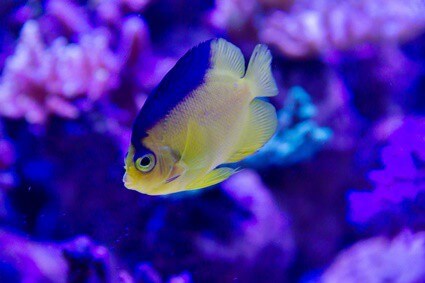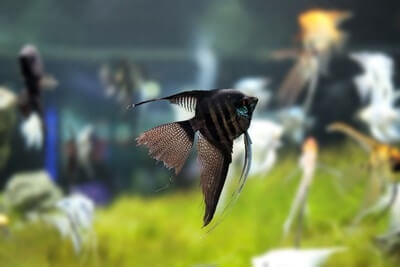While not as aggressive as their Cichlidae brothers and sisters, angelfish nip and bite other fish. They only do this when defending their territory or finding a mate.
Angelfish have a unique jaw system with teeth. It allows them to protrude their upper and lower jaw away from their head and bite down.
Angelfish most commonly bite other fish when they’re mating and breeding. Similarly, if they feel threatened, they’ll defend themselves using their teeth to cause damage.
While a natural process, sometimes you’ll need to stop overly aggressive behavior before one of the fish gets injured or killed.
Do Freshwater Angelfish Have Teeth?
Like most fish, angelfish have teeth. While there are differences between freshwater and saltwater angelfish, all varieties have teeth they can bite with.
The freshwater angelfish family consists of 3 species. These are:
- Angelfish (Pterophyllum scalare).
- Altum angelfish (Pterophyllum altum).
- Leopold’s angelfish (Pterophyllum leopoldi).
All three species of angelfish have a single nostril and two jaws. The first jaw is elastic, creating negative pressure that sucks in food and prey.
The second is the pharyngeal jaw, which is found inside the mouth. It has teeth that allow angelfish to chew their prey. They’re like bristles, helping them to grasp food. Angelfish regularly lose their teeth and replace them throughout their lives.
As well as this, the lower jaw has an extra joint that allows angelfish to bite while the jaw is extended.
As described by the Journal of Experimental Biology, an angelfish’s mouth, jaws, and teeth have evolved to allow them to feast from hard-to-reach places.
Naturally, angelfish use their teeth as a fighting mechanism.
To use them, they protrude their upper and lower jaw away from their head and bite down hard. This causes damage to any fish caught in the angelfish’s grip, often resulting in torn fins and tails.

Do Angelfish Bite Each Other?
When angelfish fight, they sometimes lock lips. At first, it seems as if the fish are kissing. But upon closer inspection, you’ll notice that this behavior comes alongside other forms of aggression.
During a fight, fish swim into one another and peck at each other’s fins. As a result, you may notice:
- Tears around the mouth, fins, and tail.
- Missing scales.
- Damage to the eyes.
- Dislocated jaws.
All of the above are signs that angelfish have used their teeth to bite their victim during a fight. But what causes them to turn on other fish?
Angelfish are part of the Cichlidae family, a fish group that includes the cichlid, Oscar fish, and blood-red parrot cichlid. Fish within this family are known for their aggressive tendencies.
While angelfish are the family’s more peaceful species, they’ll fight when necessary, using their teeth as an effective weapon.
Here are some of the most common reasons why angelfish bite each other:
Stress
Like most creatures, angelfish suffer from stress. This can be down to several factors, including:
- Loud noises.
- Overcrowding within the tank.
- Water that’s changed too frequently.
- Changes in light throughout the day.
- The constant movement inside and outside the tank.
When these stress factors combine, they activate the angelfish’s fight-or-flight response. As they can’t escape the stress, they fight each other instead. Signs of stress include:
- Tiredness.
- Dull scale coloration.
- Refusal to eat.
- Reluctance to swim.
Some of the most common signs of stress in angelfish include:
- Erratic swimming.
- Lethargy or refusal to eat.
- Color changes.
- Antisocial or aggressive behavior.
- Parallel swimming.
Water
Water changes cause angelfish extreme amounts of stress. It’s not just the process that angelfish enjoy, but the clean water itself.
A study published in Applied Animal Behavior Science found that aggressive interactions increase when 25% and 50% of water is renewed. They also remain elevated for 24 hours for 50% of water renewal.
Consider whether you could wait a bit longer when changing your angelfish’s water. While the tank needs to be clean, chemical signals are released into the water from the angelfish, which sets out dominance.
The same journal reiterates that prolonged fights can affect fish welfare by increasing the probability of injuries, stress, and detrimental impacts on fish health.
Mating Aggression
After reaching sexual maturity, angelfish feel the urge to reproduce. Angelfish can lay anywhere between 100 – 1,000 eggs at a time.
According to the Brazilian Journal of Biology, larger and more aggressive males obtained new mating opportunities. In contrast, submissive males were rejected by the females.
Females choose their partners, so male fish must compete to show dominance and win a mate. Even the more submissive male angelfish in the tank will join in with the fighting to find themselves a mate.
Similarly, once angelfish have mated, they will guard each other and attack other fish that get too close. Angelfish will use their teeth, fins, tail, and mouth to fight off competitors.
Signs of mating aggression include:
- Non-mated fish will keep their distance from mated angelfish.
- Mated angelfish become more aggressive towards the other in the tank.
- Fish become more vibrant in color to attract a mate.
To stop fish from hurting each other with their teeth when they’re fighting, remove mated angelfish from the main tank until the babies are born.
This should make the breeding angelfish feel safer and allow the rest of the tank to live more peacefully.
Breeding Aggression
Breeding aggression occurs after two angelfish have mated. They will become jealous and territorial during this time, especially over their eggs.
When the female is pregnant, she will attack any fish that attempts to come near her. She will warn them off by biting them and nipping parts of their fin and tail. The angelfish can sometimes significantly damage other fish in the tank.
The male angelfish’s job is to find a spot for the female to lay her eggs. If other fish attempt to claim the area, the male will chase them away and fight them for dominance.
However, before getting into a fight, angelfish will chase threats off first. They only resort to biting and fighting as a last resort once they feel threatened and attacked.
Overcrowding
An overcrowded tank can be a big problem. Experts agree that angelfish thrives when kept in groups of five. This prevents aggression and bullying and allows angelfish to form a school inside the tank.
Too many fish can reduce valuable swimming space. Angelfish also grow to be quite large, and many fish owners get caught out by just how big they need their tanks to be.
As a result, they usually end up with a tank that’s too small for their fish’s needs. An overcrowded tank removes important hiding spaces, meaning vulnerable fish must become more aggressive to survive.
Fish become more territorial when fighting for their area of the tank. As a result, biting and fighting are more likely to increase as the fish attempt to assert dominance. If your tank is overcrowded, you’ll notice:
- Fish gasping at the surface due to low oxygen levels.
- Heavy breathing, made evident by the rapid movement of the gills.
- Lack of swimming or eating.
- Increased aggression by fish within the tank.
- Stunted fish growth.
- High nitrate levels.
If yours contains too many fish, splitting them into more manageable groups is recommended. After a while, you should see the biting and fighting subside as the aggression calms down.
Tiredness
Sometimes, the reason for an angelfish fight is as simple as needing more rest. This is especially true in angelfish who have recently laid eggs.
To protect them the pair takes it in turns to protect them. During that time, they’ll fight off predator fish and others looking to claim more territory.
Parent angelfish also constantly swims around the eggs to create water circulation, helping to fertilize the eggs. They also spend lots of time clearing debris with their mouths and removing infertile eggs.
Combined, these lead to irritable and tired angelfish ready for a fight whenever another fish starts.
Are Angelfish Kissing or Biting?
Angelfish regularly lock lips with other fish. While this looks romantic, it’s often aggressive, and biting is almost always involved.
When determining whether your angelfish are innocently kissing or trying to hurt each other with their teeth, take notice of other behavioral signs, including:
- Hiding – bullied fish will keep themselves out of the way for safety.
- Swollen belly – which means the female is getting ready to breed.
If unsure, here are the main differences between kissing and biting.

Kissing
Angelfish don’t fight all the time. Lip-locking becomes part of the process when they’re looking for a mate. It’s a way for the fish to determine whether they’re a suitable match.
While it’s not completely clear what makes kissing a good way for angelfish to determine who they want to mate with, you’ll usually find that eggs appear in the tank soon afterward. This means the ritual worked, and the angelfish went on to breed.
Angelfish don’t necessarily mate for life, so you may see the same fish repeat the process with other partners.
Biting
In all other instances, your angelfish are fighting. This could be for several reasons that we’ve already mentioned.
As a fish owner, it’s not always pleasant to witness. However, it is a natural behavior. Unless you can watch your fish 24/7, it will happen now and then.
That being said, fish shouldn’t bite each other too often. If your angelfish regularly take chunks out of each other, investigate what’s causing the aggression. By removing the source, they should hopefully calm down.
While you do so, you may need to separate the aggressive fish from the quieter ones so that they can live in peace.
Allowing quiet fish a chance to assert their dominance helps create more balance within the aquarium.
Do Angelfish Bite Humans?
If you put your fingers into your angelfish tank, there’s every chance you’re in for a nibble.
If your fish defend their eggs and territory and see your fingers as a threat, they will bite and yank you to warn you off. This might hurt, depending on the strength of your angelfish’s grip.
Similarly, placing your fingers inside a live aquarium is stressful for the fish. It unbalances the harmony inside the tank, and many fish will see you as a predator. The more aggressive, brave fish in the tank will bite you instead of hiding away.
Angelfish may also see your fingers as food if they associate your body parts with getting fed. Some fish owners prefer to hand feed, and angelfish can’t necessarily tell the difference between the food and your fingers. To prevent yourself from being bitten, you should:
- Only ever put your fingers into the tank in an emergency.
- Pour the food in instead of hand feeding.
- Make sure your hands are clean from chemicals and solvents.
- Place a plaster on all open wounds so you don’t corrupt the water.
You can’t stop your angelfish from using their teeth when they fight. You can prevent bites by providing a healthy environment for them to live in and monitoring aggressive behavior.







